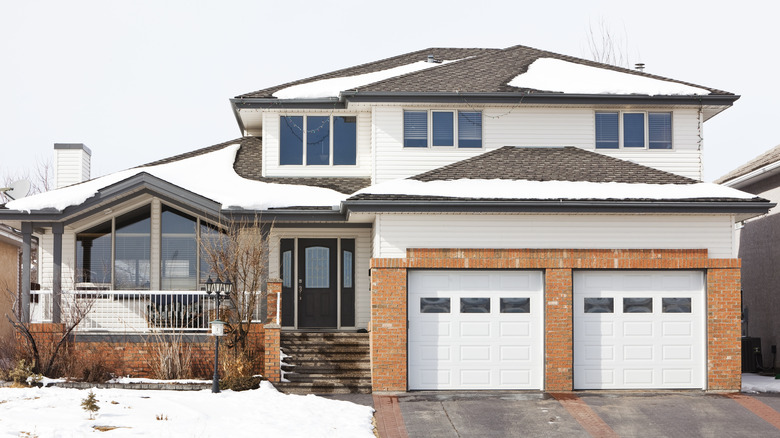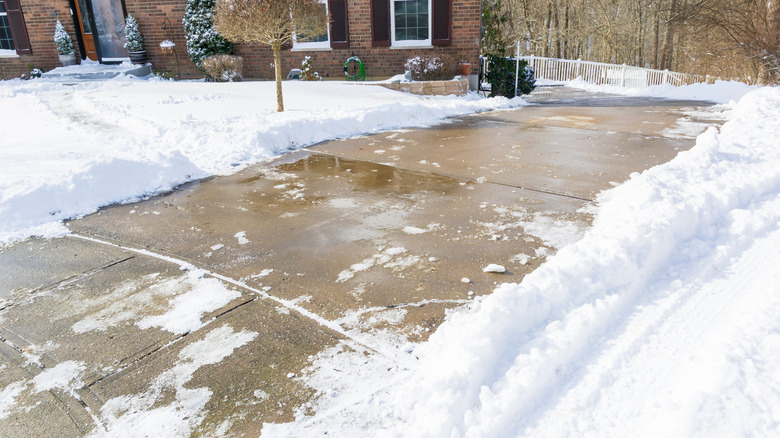What To Know About Heated Driveways Before Investing
One of the worst parts about winter is the constant shoveling and salting that needs to be done after each storm. Nobody likes walking out the front door to sink their feet into inches of snow or trying to carefully maneuver dangerous patches of ice. While there isn't an all-encompassing way to avoid dealing with these conditions throughout the season, a heated driveway may offer the relief you need.
A heated driveway works similarly to that of heated flooring, using radiant heat to warm driveways of all different mediums, whether that be asphalt, concrete, or pavers. Two different types of systems can be installed: electric or hydronic. Electrically heated driveways are noted to be simpler to install, easy to customize, quiet in their operation, and require less space to run. On the other hand, a hydronic system is run by a boiler, using water and antifreeze to melt snow and ice. At first glance, it may seem like a no-brainer to install a heated driveway — its convenience and safety measures are certainly a perk. However, there are also some downsides to consider, especially regarding the cost. You'll certainly need to hire a professional, so if you live in an area that doesn't see much snow or ice throughout the winter, this may not be the most practical option for you.
The pros of a heated driveway
A heated driveway can help resolve much of one's hate for winter, providing a way to avoid constant shoveling and salting throughout the season. These systems can work on both manual and automated settings, enabling you to go in and activate the driveway to begin heating if expecting a storm, or it will automatically detect snow, ice, and cold temperatures and kick on and off as needed. Typically, heated driveways melt 2 inches of snow/ice per hour, keeping the space clear enough for any travel that is necessary as the storm sweeps through.
Eliminating ice from your driveway will increase safety throughout the cold months, especially for children and older people. Additionally, you won't have to worry about applying salt anymore. Not only will this save you money and time, but melting salts contain harmful chemicals to pets and wildlife as they often run off and contaminate nearby water and soil. It is deteriorating for our driveways, lawns, and cars as well. You can expect to get a long life out of your heated driveway, with systems usually lasting at least 15 to 20 years. But, this longevity doesn't come without maintenance and a hefty cost.
Here are the downsides
Although heated driveways have many benefits, they're not always affordable. Installation is expensive and has many hidden costs that many may overlook. In addition to installing the actual system, you'll likely have to remove your current driveway and have a new one laid after the system is in place. You'll need to consider the material of your driveway, as asphalt is more expensive to heat than concrete. You should also expect an increase in utility bills. An electric system will be cheaper to install initially, with a larger impact on utility costs. At the same time, a hydronic setup will be more costly upon installation but will prove to be energy efficient. For a heated driveway, you're looking at as low as $1,300 to $9,000 or higher based on driveway material, size, maintenance, and chosen system.
Heated driveways eliminate ice and snow on the driveway, but this won't extend to steps or other elevated walkways. While these systems can last many years, repairs will appear, which will also be costly and invasive. With electric systems, you could see issues with the control board throughout the years, and hydronic systems will need annual checks on the boiler. If tubing in a hydronic setup is damaged, portions of the driveway must be removed to repair them, and a broken boiler costs thousands of dollars to replace. Clearly, the most significant downside to a heated driveway is the cost, and this isn't something that can be easily DIYed.


